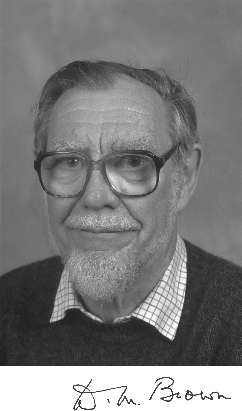Daniel McGillivray Brown facts for kids
Quick facts for kids
Daniel McGillivray Brown
FRS
|
|
|---|---|
 |
|
| Born | 3 February 1923 Giffnock, Scotland
|
| Died | 24 April 2012 (aged 89) Cambridge, England
|
| Nationality | British |
| Alma mater | Glasgow University |
| Known for | Mutagenics Structure of RNA |
| Scientific career | |
| Institutions |
|
Daniel McGillivray Brown (born February 3, 1923 – died April 24, 2012) was a Scottish scientist. He was a chemist who studied nucleic acids. These are important molecules like DNA and RNA that carry genetic information in living things.
Contents
Early Life and Education
Daniel McGillivray Brown was born in Giffnock, Scotland, on February 3, 1923. His father, David, owned a restaurant, and his mother, Catherine, was a teacher. Daniel went to Giffnock Primary School. Later, he attended Glasgow Academy.
When he was 17, Daniel went to Glasgow University. He studied chemistry there and earned a special degree with honors.
Starting His Career
In 1945, Daniel moved to London. He joined the Chester Beatty Research Institute. Here, he worked on creating new chemical compounds. This work helped him earn his first PhD degree. A PhD is a very high university degree.
In 1948, Daniel moved to Cambridge. He joined a research group led by a famous scientist named Alexander Todd. Daniel earned his second PhD in 1952.
Teaching and Research Roles
Daniel became a lecturer in the chemistry department at University of Cambridge in 1959. Later, he became a reader in 1967. During this time, he also worked as a visiting professor. He taught at the University of California, Los Angeles from 1959 to 1960. He also taught at Brandeis University from 1966 to 1967.
In 1968, he received another advanced degree, an Sc.D. By 1974, he became Vice-Provost at Kings College.
Later Years and Retirement
In 1981, Daniel took a break from his work. He spent time at the Laboratory of Molecular Biology (LMB). This is a famous research center. He liked it so much that he moved there permanently a year later.
Daniel officially retired from the LMB in 2002. However, he continued to publish his scientific work until 2008.
Key Discoveries and Contributions
At Cambridge, Daniel Brown focused on understanding the structure of nucleic acids. He wanted to confirm the shape of the sugar part in these molecules. At the time, scientists only guessed what it looked like.
Daniel and his colleague, Basil Lythgoe, proved the correct shape. This was a big step forward. He then worked on how to add phosphate groups to nucleosides. This process creates nucleotides.
Understanding RNA and DNA
His work was very important for understanding the chemical structures of RNA. RNA is a molecule that helps carry genetic instructions. His discoveries also helped scientists understand DNA. DNA is the main molecule that carries genetic information.
Later, Daniel also studied phosphoinositides. These are important fats found in cell membranes. He also researched mutagenesis. This is the process where changes happen in the DNA sequence.
Personal Life
Daniel Brown met Margaret Joyce Herbert in 1952. They met at Scottish Highland Dancing classes. They got married the next year in Lincolnshire.
Daniel and Margaret had four children together:
- Catherine (born 1954)
- David (born 1955)
- Frances (born 1961)
- Moira (born 1963)
Daniel McGillivray Brown passed away at his home in Cambridge on April 24, 2012. He was survived by his wife, three of his daughters, four grandchildren, and a great-granddaughter.
Honors and Awards
In 1982, Daniel Brown became a Fellow of the Royal Society. This is a very high honor for scientists in the United Kingdom. It means he was recognized for his important contributions to science.
Images for kids


